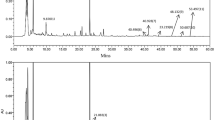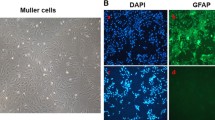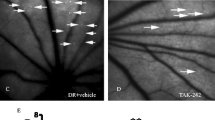Abstract
Purpose
To investigate the effect of spleen tyrosine kinase (Syk) inhibitor R406 on diabetic retinopathy (DR) in diabetic mellitus (DM) rats.
Methods
Rats were randomized into Normal, DM, DM + 5 mg/kg R406 and DM + 10 mg/kg R406 groups. DM rats were established via injection of streptozotocin (STZ). One week after model establishment, rats in treatment groups received 5 mg/kg or 10 mg/kg R406 by gavage administration for 12 weeks consecutively, followed by the detection with hematoxylin-eosin (HE) staining, Evans blue angiography, retinal trypsin digestion assay, Western blotting, immunohistochemistry, TUNEL assay, immunofluorescence assay and quantitative reverse transcriptase real-time polymerase chain reaction (qRT-PCR).
Results
The retina of DM rats presented different degree of edema, disordered and loose structure, swollen cells with enlarged intercellular space, and dilated and congested capillaries. Besides, the retinal vessels of DM rats showed high fluorescence leakage. However, R406 alleviated the above-mentioned conditions, which was much better with high concentration of R406 (10 mg/kg). R406 also reversed the down-regulations of occludin, claudin-5, ZO-1 and the up-regulation of and VEGF in retinal tissues of DM rats; inhibited retinal cell apoptosis; strengthened retinal cell proliferation; and reduced expressions of IL-1β, IL-6, TNF-α and nuclear p65 NF-κB in retinal tissues. The improvement in all these indexes was much more significant in rats of DM + 10 mg/kg R406 group than in rats of DM + 5 mg/kg R406 group.
Conclusion
Syk inhibitor R406 could attenuate retinal inflammation in DR rats via the repression of NF-κB activation.





Similar content being viewed by others
References
Matough FA, Budin SB, Hamid ZA, Alwahaibi N, Mohamed J (2012) The role of oxidative stress and antioxidants in diabetic complications. Sultan Qaboos Univ Med J 12(1):5–18. https://doi.org/10.12816/0003082
Harries AD, Satyanarayana S, Kumar AM, Nagaraja SB, Isaakidis P, Malhotra S, Achanta S, Naik B, Wilson N, Zachariah R, Lonnroth K, Kapur A (2013) Epidemiology and interaction of diabetes mellitus and tuberculosis and challenges for care: a review. Public Health Action 3(Suppl 1):S3–S9. https://doi.org/10.5588/pha.13.0024
Tang J, Kern TS (2011) Inflammation in diabetic retinopathy. Prog Retin Eye Res 30(5):343–358. https://doi.org/10.1016/j.preteyeres.2011.05.002
Kastelan S, Tomic M, Gverovic Antunica A, Salopek Rabatic J, Ljubic S (2013) Inflammation and pharmacological treatment in diabetic retinopathy. Mediat Inflamm 2013:213130. https://doi.org/10.1155/2013/213130
Liu L, Wu X, Liu L, Geng J, Yuan Z, Shan Z, Chen L (2012) Prevalence of diabetic retinopathy in mainland China: a meta-analysis. PLoS ONE 7(9):e45264. https://doi.org/10.1371/journal.pone.0045264
Taniguchi T, Kobayashi T, Kondo J, Takahashi K, Nakamura H, Suzuki J, Nagai K, Yamada T, Nakamura S, Yamamura H (1991) Molecular cloning of a porcine gene syk that encodes a 72-kDa protein-tyrosine kinase showing high susceptibility to proteolysis. J Biol Chem 266(24):15790–15796
Ni B, Hu J, Chen D, Li L, Chen D, Wang J, Wang L (2016) Alternative splicing of spleen tyrosine kinase differentially regulates colorectal cancer progression. Oncol Lett 12(3):1737–1744. https://doi.org/10.3892/ol.2016.4858
Nakashima H, Natsugoe S, Ishigami S, Okumura H, Matsumoto M, Hokita S, Aikou T (2006) Clinical significance of nuclear expression of spleen tyrosine kinase (Syk) in gastric cancer. Cancer Lett 236(1):89–94. https://doi.org/10.1016/j.canlet.2005.05.022
Yang WS, Chang JW, Han NJ, Lee SK, Park SK (2012) Spleen tyrosine kinase mediates high glucose-induced transforming growth factor-beta1 up-regulation in proximal tubular epithelial cells. Exp Cell Res 318(15):1867–1876. https://doi.org/10.1016/j.yexcr.2012.05.016
Scott DL (2011) Role of spleen tyrosine kinase inhibitors in the management of rheumatoid arthritis. Drugs 71(9):1121–1132. https://doi.org/10.2165/11591480-000000000-00000
Al-Harbi NO, Nadeem A, Ahmad SF, Alanazi MM, Aldossari AA, Alasmari F (2019) Amelioration of sepsis-induced acute kidney injury through inhibition of inflammatory cytokines and oxidative stress in dendritic cells and neutrophils respectively in mice: role of spleen tyrosine kinase signaling. Biochimie 158:102–110. https://doi.org/10.1016/j.biochi.2018.12.014
Kitai M, Fukuda N, Ueno T, Endo M, Maruyama T, Abe M, Okada K, Soma M, Matsumoto K (2017) Effects of a spleen tyrosine kinase inhibitor on progression of the lupus nephritis in mice. J Pharmacol Sci 134(1):29–36. https://doi.org/10.1016/j.jphs.2017.02.015
Vanlandingham PA, Nuno DJ, Quiambao AB, Phelps E, Wassel RA, Ma JX, Farjo KM, Farjo RA (2017) Inhibition of Stat3 by a small molecule inhibitor slows vision loss in a rat model of diabetic retinopathy. Invest Ophthalmol Vis Sci 58(4):2095–2105. https://doi.org/10.1167/iovs.16-20641
Wang M, Wang Y, Xie T, Zhan P, Zou J, Nie X, Shao J, Zhuang M, Tan C, Tan J, Dai Y, Sun J, Li J, Li Y, Shi Q, Leng J, Wang X, Yao Y (2019) Prostaglandin E2/EP2 receptor signalling pathway promotes diabetic retinopathy in a rat model of diabetes. Diabetologia 62(2):335–348. https://doi.org/10.1007/s00125-018-4755-3
Bukong TN, Iracheta-Vellve A, Gyongyosi B, Ambade A, Catalano D, Kodys K, Szabo G (2016) Therapeutic benefits of spleen tyrosine kinase inhibitor administration on binge drinking-induced alcoholic liver injury, steatosis, and inflammation in mice. Alcohol Clin Exp Res 40(7):1524–1530. https://doi.org/10.1111/acer.13096
Yang WS, Seo JW, Han NJ, Choi J, Lee KU, Ahn H, Lee SK, Park SK (2008) High glucose-induced NF-kappaB activation occurs via tyrosine phosphorylation of IkappaBalpha in human glomerular endothelial cells: involvement of Syk tyrosine kinase. Am J Physiol Renal Physiol 294(5):F1065–F1075. https://doi.org/10.1152/ajprenal.00381.2007
Yang WS, Kim JS, Han NJ, Lee MJ, Park SK (2015) Toll-like receptor 4/spleen tyrosine kinase complex in high glucose signal transduction of proximal tubular epithelial cells. Cell Physiol Biochem Int J Expe Cell Physiol Biochem Pharmacol 35(6):2309–2319. https://doi.org/10.1159/000374034
Zhou H, Yue Y, Wang J, Ma Q, Chen Y (2018) Melatonin therapy for diabetic cardiomyopathy: a mechanism involving Syk-mitochondrial complex I-SERCA pathway. Cell Signal 47:88–100. https://doi.org/10.1016/j.cellsig.2018.03.012
Wuopio J, Ostgren CJ, Lanne T, Lind L, Ruge T, Carlsson AC, Larsson A, Nystrom FH, Arnlov J (2018) The association between circulating endostatin and a disturbed circadian blood pressure pattern in patients with type 2 diabetes. Blood Press 27(4):215–221. https://doi.org/10.1080/08037051.2018.1444941
Rong L, Gu X, Xie J, Zeng Y, Li Q, Chen S, Zou T, Xue L, Xu H, Yin ZQ (2018) Bone marrow CD133(+) stem cells ameliorate visual dysfunction in streptozotocin-induced diabetic mice with early diabetic retinopathy. Cell Transpl 27(6):916–936. https://doi.org/10.1177/0963689718759463
Zhu Y, Herlaar E, Masuda ES, Burleson GR, Nelson AJ, Grossbard EB, Clemens GR (2007) Immunotoxicity assessment for the novel Spleen tyrosine kinase inhibitor R406. Toxicol Appl Pharmacol 221(3):268–277. https://doi.org/10.1016/j.taap.2007.03.027
Alzahrani KS, Nadeem A, Ahmad SF, Al-Harbi NO, Ibrahim KE, El-Sherbeeny AM, Alhoshani AR, Alshammari MA, Alotaibi MR, Al-Harbi MM (2019) Inhibition of spleen tyrosine kinase attenuates psoriasis-like inflammation in mice through blockade of dendritic cell-Th17 inflammation axis. Biomed Pharmacother Biomed Pharmacother 111:347–358. https://doi.org/10.1016/j.biopha.2018.12.060
Kurniawan DW, Jajoriya AK, Dhawan G, Mishra D, Argemi J, Bataller R, Storm G, Mishra DP, Prakash J, Bansal R (2018) Therapeutic inhibition of spleen tyrosine kinase in inflammatory macrophages using PLGA nanoparticles for the treatment of non-alcoholic steatohepatitis. J Controll Release Off J Controll Release Soc 288:227–238. https://doi.org/10.1016/j.jconrel.2018.09.004
Braselmann S, Taylor V, Zhao H, Wang S, Sylvain C, Baluom M, Qu K, Herlaar E, Lau A, Young C, Wong BR, Lovell S, Sun T, Park G, Argade A, Jurcevic S, Pine P, Singh R, Grossbard EB, Payan DG, Masuda ES (2006) R406, an orally available spleen tyrosine kinase inhibitor blocks fc receptor signaling and reduces immune complex-mediated inflammation. J Pharmacol Exp Ther 319(3):998–1008. https://doi.org/10.1124/jpet.106.109058
Arredondo Zamarripa D, Noguez Imm R, Bautista Cortes AM, Vazquez Ruiz O, Bernardini M, Fiorio Pla A, Gkika D, Prevarskaya N, Lopez-Casillas F, Liedtke W, Clapp C, Thebault S (2017) Dual contribution of TRPV4 antagonism in the regulatory effect of vasoinhibins on blood-retinal barrier permeability: diabetic milieu makes a difference. Sci Rep 7(1):13094. https://doi.org/10.1038/s41598-017-13621-8
Assmann JC, Muller K, Wenzel J, Walther T, Brands J, Thornton P, Allan SM, Schwaninger M (2017) Isolation and cultivation of primary brain endothelial cells from adult mice. Bio-protocol. https://doi.org/10.21769/bioprotoc.2294
Imai S, Otsuka T, Naito A, Shimazawa M, Hara H (2017) Triamcinolone acetonide suppresses inflammation and facilitates vascular barrier function in human retinal microvascular endothelial cells. Curr Neurovascu Res 14(3):232–241. https://doi.org/10.2174/1567202614666170619081929
Paine SK, Mondal LK, Borah PK, Bhattacharya CK, Mahanta J (2017) Pro- and antiangiogenic VEGF and its receptor status for the severity of diabetic retinopathy. Mol Vis 23:356–363
Khalaf N, Helmy H, Labib H, Fahmy I, El Hamid MA, Moemen L (2017) Role of angiopoietins and Tie-2 in Diabetic Retinopathy. Electron Phys 9(8):5031–5035. https://doi.org/10.19082/5031
Kazerounian S, Duquette M, Reyes MA, Lawler JT, Song K, Perruzzi C, Primo L, Khosravi-Far R, Bussolino F, Rabinovitz I, Lawler J (2011) Priming of the vascular endothelial growth factor signaling pathway by thrombospondin-1, CD36, and spleen tyrosine kinase. Blood 117(17):4658–4666. https://doi.org/10.1182/blood-2010-09-305284
Barber AJ, Gardner TW, Abcouwer SF (2011) The significance of vascular and neural apoptosis to the pathology of diabetic retinopathy. Invest Ophthalmol Vis Sci 52(2):1156–1163. https://doi.org/10.1167/iovs.10-6293
Dasgupta N, Thakur BK, Ta A, Dutta P, Das S (2017) Suppression of spleen tyrosine kinase (Syk) by histone deacetylation promotes, whereas BAY61-3606, a synthetic Syk Inhibitor abrogates colonocyte apoptosis by ERK activation. J Cell Biochem 118(1):191–203. https://doi.org/10.1002/jcb.25625
Qiao Y, Xixi T, Li M, Shengyu L, Yufeng C, Meiting X, Yahui H, Pengfei Z, Guangfeng L, Yue S (2018) Spleen tyrosine kinase promotes NLR family pyrin domain containing 3 inflammasome-mediated IL-1β secretion via c-Jun N-terminal kinase activation and cell apoptosis during diabetic nephropathy. Mol Med Rep 18:1995–2008
Modi TG, Chalishazar M, Kumar M (2018) Expression of Ki-67 in odontogenic cysts: a comparative study between odontogenic keratocysts, radicular cysts and dentigerous cysts. J Oral Maxillofac Pathol JOMFP 22(1):146. https://doi.org/10.4103/jomfp.JOMFP_94_16
Repana K, Papazisis K, Foukas P, Valeri R, Kortsaris A, Deligiorgi E, Kyriakidis D (2006) Expression of Syk in invasive breast cancer: correlation to proliferation and invasiveness. Anticancer Res 26(6C):4949–4954
Cortez M, Carmo LS, Rogero MM, Borelli P, Fock RA (2013) A high-fat diet increases IL-1, IL-6, and TNF-alpha production by increasing NF-kappaB and attenuating PPAR-gamma expression in bone marrow mesenchymal stem cells. Inflammation 36(2):379–386. https://doi.org/10.1007/s10753-012-9557-z
Cui S, Bilitewski U (2013) Anti-inflammatory effect of Syk inhibitor in LPS stimulated macrophages. Xi bao yu fen zi mian yi xue za zhi Chin J Cell Mol Immunol 29(10):1024–1027
Ishizuka F, Shimazawa M, Inoue Y, Nakano Y, Ogishima H, Nakamura S, Tsuruma K, Tanaka H, Inagaki N, Hara H (2013) Toll-like receptor 4 mediates retinal ischemia/reperfusion injury through nuclear factor-κB and spleen tyrosine kinase activation. Investig Ophthalmol Vis Sci 54(8):5807–5816
Adhi M, Cashman SM, Kumar-Singh R (2013) Adeno-associated virus mediated delivery of a non-membrane targeted human soluble CD59 attenuates some aspects of diabetic retinopathy in mice. PLoS ONE 8(10):e79661. https://doi.org/10.1371/journal.pone.0079661
National Research Council (2011) Guide for the care and use of laboratory animals: Eighth Edition. Washington, DC: The National Academies Press. https://doi.org/10.17226/12910
Acknowledgements
Not applicalbe.
Author information
Authors and Affiliations
Corresponding author
Ethics declarations
Conflict of interest
The authors declare that they have no competing interests.
Ethical statement
The study conformed to the Guide for the Care and Use of Laboratory Animals [40], and all animal experiments were conducted with the approval of Medical Ethics Committee of Laboratory Animals in the First Hospital of Shijiazhuang City.
Additional information
Publisher's Note
Springer Nature remains neutral with regard to jurisdictional claims in published maps and institutional affiliations.
Rights and permissions
About this article
Cite this article
Su, X., Sun, ZH., Ren, Q. et al. The effect of spleen tyrosine kinase inhibitor R406 on diabetic retinopathy in experimental diabetic rats. Int Ophthalmol 40, 2371–2383 (2020). https://doi.org/10.1007/s10792-020-01422-4
Received:
Accepted:
Published:
Issue Date:
DOI: https://doi.org/10.1007/s10792-020-01422-4




